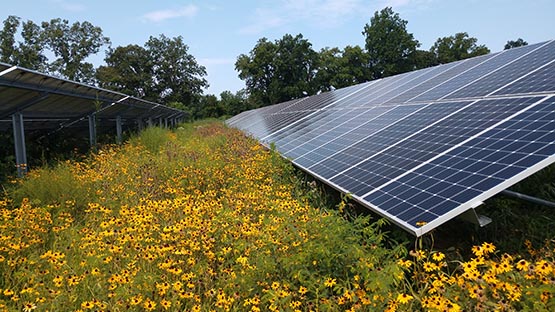
The city of Harrisonburg and Harrisonburg Downtown Renaissance launched Harrisonburg Downtown 2040, a visioning process to help inform how downtown will progress over the next 20 years. Visit the link to make your ideas known; they hope to hear from everyone, even if you aren’t a resident.
Politics and Policy
John Kerry said the US may introduce a carbon fee on imports from countries that don’t tax heavy greenhouse gas (GHG) polluters. EPA’s McCarthy said existing nuclear power plants will be needed for the Biden administration’s effort to reduce GHG emissions. EPA issued a final rule setting methane emission thresholds for municipal solid waste landfills, giving landfill operators 30 months to install appropriate systems to meet the standards. The administration announced a major push to cut carbon emissions from federal buildings and homes by setting new efficiency standards and investing in innovative research. It also took the first step to reinstate an energy efficiency standard for light bulbs, a move that’s expected to favor incandescent bulbs over LEDs.
Achieving effective climate policies is proving divisive. Two camps disagree on how to decarbonize Colorado: Gov. Polis favors public investment and an incentives-based approach; a group of state legislators and environmentalists wants a hard mandate to cut emissions across the economy. A wind and solar project proposal near a 7,000 year-old sacred Indigenous spiritual site has divided a Minnesota community. Environmental advocates are arguing over a “clean electricity” versus a “renewable electricity” standard for federal climate legislation. Except in Washington DC, support for putting a price on CO2 emissions is steadily spreading. Catholic support was on display during a weekend climate change conference; two bishops touted it as a critical, effective and “eminently doable” climate solution. The Alliance for Market Solutions announced the launch of an advocacy campaign to garner support on Capitol Hill.
President Biden signed an executive order directing several federal departments and agencies to analyze the risks climate change poses to the US financial system and federal government. Politico said the measures will reach well beyond Wall Street. In a 7-1 decision that will impact similar climate liability lawsuits against the fossil fuel industry, the US Supreme Court ruled the 4th US Circuit Court of Appeals must take a fresh look at the remand order that sent Baltimore’s liability case against BP back to the original state court. As EVs increase in numbers on the nation’s highways, states and the federal government must come up with an equitable system for raising funds for road construction and maintenance.
The world can still reach net-zero carbon emissions by 2050, but only if governments redouble their efforts, all fossil fuel investment is halted, and renewable energy capacity and infrastructure are added at unprecedented scale, according to an International Energy Agency (IEA) report. Asian energy officials disputed the IEA’s approach, viewing it as too narrow. A proposed climate law passed the French National Assembly and moved on to the Senate, but has sharply divided the country. Britain’s Emissions Trading System kicked off with carbon prices reaching over $70/metric ton, making the cost of polluting in Britain higher than in the EU. A debt-for-climate swap plan is expected from the IMF and World Bank ahead of COP26, and if done right, could be highly effective in addressing both spiraling low- and middle-income country debt and the climate crisis. Even if the Biden administration sets a deadline to sunset sales of gas-powered passenger vehicles in the US, the export of used cars could stall global reductions in CO2 emissions needed to stave off catastrophic warming.
Climate and Climate Science
Chemical and Engineering News’ cover article addressed replenishing depleted soil as a means of removing CO2 from the atmosphere, and the scientific and policy issues associated with it. Fires in far northern forests that smolder throughout winter and erupt again in spring could become more common. Glaciers, like the soil, have their own community of microbes, their own microbiome—transforming them from what we thought were sterile wastelands into vibrant ecosystems that can control how fast glaciers melt and possibly influencing the global climate.
A new NRDC and others’ report shows climate change health costs now far exceed $820bn/year in the US. A Nature Communications study said sea level rise from global warming caused approximately 13% ($8.1bn) of the $62.7bn in damages associated with 2012’s Superstorm Sandy. Trees poisoned and killed by saltwater from rising seas are emitting GHGs, prompting researchers to warn of a warming source that could become worse as rising seas encroach on forests.
A new guidance document aims to help National Park Service ecologists and managers confront that they must now actively choose what to save, what to shepherd through radical environmental transformation, and what to let vanish forever. When it comes to the highest surface temperature, Iran’s Lut Desert and the Sonoran Desert along the Mexican‑US border have Death Valley beat, having recently reached a sizzling 80.8°C (177.4°F). Extreme heat risks may be widely underestimated and sometimes left out of major climate reports; new studies sharpen warnings for unlivable heat in the tropics, and nearly unthinkable extremes in major Northern Hemisphere cities.
A significant part of the Greenland ice sheet is on the brink of a tipping point, after which accelerated melting would become inevitable even if global warming was halted. The Arctic is now warming three times as fast as the global average and faces an ongoing barrage of dangerous climate and environmental pollutants, Arctic Council experts warned at the start of meetings in Reykjavik, Iceland. A drastic drop in caribou and shorebird populations is a reflection of the dire changes unfolding on the Arctic tundra. As part of the Ronne Ice Shelf’s “natural cycle”, a huge ice block has broken off from western Antarctica into the Weddell Sea, becoming the largest iceberg in the world.
NOAA forecasts a 60% chance of an above-normal hurricane season, a 30% chance of a near-normal season and only a 10% chance of a below-normal season.
Energy
Air France-KLM launched its first long-haul flight powered by sustainable aviation fuel, petroleum mixed with a synthetic jet fuel derived from waste cooking oils. Over the next year, at a research site run by NASA on the fringes of the Mojave Desert, companies will demonstrate their best efforts at eliminating carbon pollution from aviation via a new generation of electric airplanes. Canada-based seaplane airline Harbour Air aims to offer zero‑emission, all-electric commercial flights by 2022.
The combination of falling solar prices, forceful prodding from their members, and progressive top leadership resulted in central Virginia’s Old Dominion Electric Cooperative having 30 MW of operating solar, another 135 MW on the way soon, and a pending proposal for another 400 MW in the next four years. Solar groups and Virginia’s lead energy agency are asking the State Corporation Commission to hold a hearing on Dominion Energy’s plans to charge shared solar customers a minimum monthly bill of ~$75, contending the price tag could hinder customer participation.
In a Dearborn, MI presentation, Ford Motor Co unveiled an electric version of its popular F-150 pickup truck—the Lightning—aimed at small businesses and corporate customers such as building contractors and mining and construction companies that buy rugged pickups. Ford and South Korean battery maker SK Innovation announced they will form a battery joint venture in North America to support Ford’s EV rollout. Duckyang Industrial Co. said it will invest $10mn and hire 285 people northeast of Atlanta to make battery modules and energy storage systems for SK Innovation’s plant. To jump-start EV battery recycling, governments and industry are putting money into an array of research initiatives.
A new Ohio River Valley Institute report estimates the cost of cleaning up all abandoned coal mine land is more than double what the federal inventory previously claimed — $26bn. Malta Inc. and Duke Energy, using a Department of Energy grant, will examine integrating Malta’s 100 MW, 10‑hour pumped heat energy storage system into existing infrastructure at a Duke Energy coal plant in North Carolina. Lithium-ion batteries are dominant in the EV market; several other battery types are vying to dominate the grid storage market.
China’s CO2 emissions rose 9% in Q121 compared with pre-pandemic levels, driven by a carbon-intensive economic recovery and big hikes in steel and cement output. Presidents Xi Jinping and Vladimir Putin witnessed via video link the groundbreaking ceremony of four advanced nuclear reactors powered by Russia’s third-generation nuclear technology in China. Wind turbine maker Vestas unveiled new technology to enable wind turbine blades to be fully recycled, avoiding the dumping of old blades in landfills.
Potpourri
Christopher D. Stone, a legal scholar who argued in a seminal 1972 paper that trees, rivers, oceans, and nature itself possess fundamental legal rights, died May 1 at 83. New research shows organized climate denial remains funded mostly by anonymous donors; funding has increased at a steady rate of around 3.4% per year over the past two decades. Bill McKibben wrote of a new book from the British psychoanalyst Sally Weintrobe, Psychological Roots of the Climate Crisis: Neoliberal Exceptionalism and the Culture of Uncare. Cyril Christo had an homage to the Himalayas at The Hill. Carbon Brief had a guest post explaining how world weather attribution works.
Closing Thought
There is a new dimension to the controversy over climate communication — at its heart is the question of how “depressing” or “hopeful” it should be.
Compiled by Les Grady, CAAV Steering Committee










